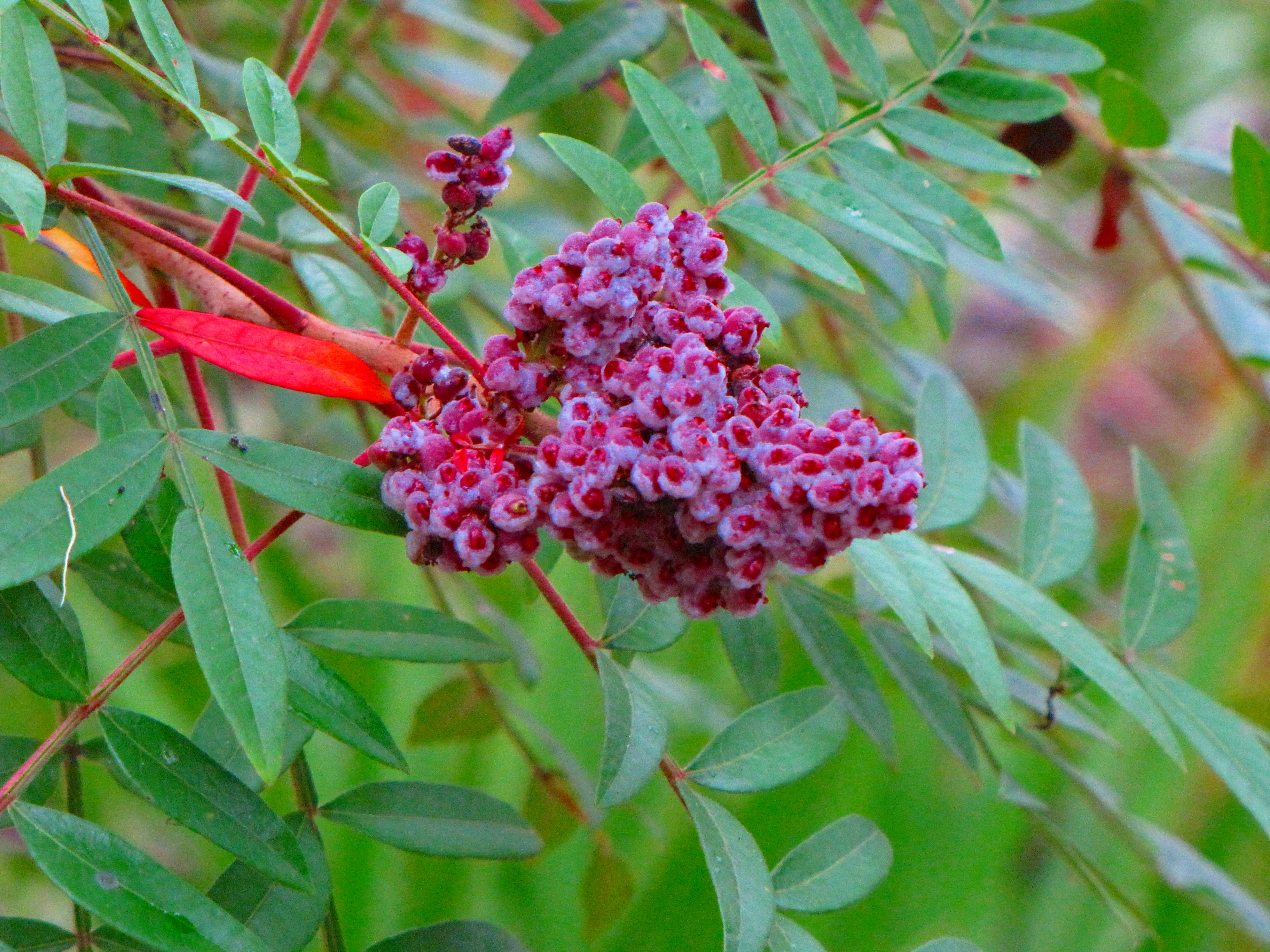Winged Sumac on:
[Wikipedia]
[Google]
[Amazon]
''Rhus copallinum'' (''Rhus copallina'' is also used but, this is not consistent with the rules of the International Association for Plant Taxonomy), the winged sumac, shining sumac, dwarf sumac or flameleaf sumac, is a species of
 Shining sumac is often cultivated, where it is well-suited to natural and informal landscapes because it has underground runners which spread to provide dense, shrubby cover for birds and wildlife. This species is valued for ornamental planting because of its lustrous dark green foliage which turns a brilliant orange-red in fall. The fall color display is frequently enjoyed along interstate highways, as the plant readily colonizes these and other disturbed sites. The tiny, greenish-yellow
Shining sumac is often cultivated, where it is well-suited to natural and informal landscapes because it has underground runners which spread to provide dense, shrubby cover for birds and wildlife. This species is valued for ornamental planting because of its lustrous dark green foliage which turns a brilliant orange-red in fall. The fall color display is frequently enjoyed along interstate highways, as the plant readily colonizes these and other disturbed sites. The tiny, greenish-yellow
Bioimages: ''Rhus copallinum''USDA Plants profile for ''Rhus copallinum'' (winged sumac)
{{Taxonbar, from=Q7245720 copallina Trees of Cuba Trees of the Eastern United States Trees of Ontario Trees of the Southeastern United States Plants described in 1753 Taxa named by Carl Linnaeus
flowering plant
Flowering plants are plants that bear flowers and fruits, and form the clade Angiospermae (), commonly called angiosperms. The term "angiosperm" is derived from the Greek words ('container, vessel') and ('seed'), and refers to those plants th ...
in the cashew family (Anacardiaceae) that is native to eastern North America. It is a deciduous
In the fields of horticulture and Botany, the term ''deciduous'' () means "falling off at maturity" and "tending to fall off", in reference to trees and shrubs that seasonally shed leaves, usually in the autumn; to the shedding of petals, ...
tree
In botany, a tree is a perennial plant with an elongated stem, or trunk, usually supporting branches and leaves. In some usages, the definition of a tree may be narrower, including only woody plants with secondary growth, plants that are ...
growing to tall and an equal spread with a rounded crown. A 5-year-old sapling will stand about .
Description
 Shining sumac is often cultivated, where it is well-suited to natural and informal landscapes because it has underground runners which spread to provide dense, shrubby cover for birds and wildlife. This species is valued for ornamental planting because of its lustrous dark green foliage which turns a brilliant orange-red in fall. The fall color display is frequently enjoyed along interstate highways, as the plant readily colonizes these and other disturbed sites. The tiny, greenish-yellow
Shining sumac is often cultivated, where it is well-suited to natural and informal landscapes because it has underground runners which spread to provide dense, shrubby cover for birds and wildlife. This species is valued for ornamental planting because of its lustrous dark green foliage which turns a brilliant orange-red in fall. The fall color display is frequently enjoyed along interstate highways, as the plant readily colonizes these and other disturbed sites. The tiny, greenish-yellow flower
A flower, sometimes known as a bloom or blossom, is the reproductive structure found in flowering plants (plants of the division Angiospermae). The biological function of a flower is to facilitate reproduction, usually by providing a mechani ...
s, borne in compact, terminal panicles, are followed by showy red clusters of berries which persist into the winter and attract wildlife.
The flowers are yellow, flowering in the summer. The fruit attracts birds with no significant litter problem, is persistent on the tree and showy.
The bark is thin and easily damaged from mechanical impact; branches droop as the tree grows, and will require pruning for vehicular or pedestrian clearance beneath the canopy; routinely grown with, or trainable to be grown with, multiple trunks. The tree wants to grow with several trunks but can be trained to grow with a single trunk. It has no thorns.
Cultivation and uses
The tree can be planted in a container or above-ground planter. It has been recommended for buffer strips around parking lots or for median strip plantings in the highway, and for land reclamation. ''Rhus copallinum'' can tolerate exposure to salt spray in maritime forests and coastal grasslands; it can grow in serpentine soil and shallow, rocky soil. The tree grows in full sun or part shade. Soil tolerances include clay, loam, sand, slightly alkaline, acidic, and well-drained soil. Its drought tolerance is high. The somewhat sour berrylike fruits are edible and rich invitamin A
Vitamin A is a fat-soluble vitamin and an essential nutrient for humans. It is a group of organic compounds that includes retinol, retinal (also known as retinaldehyde), retinoic acid, and several provitamin A carotenoids (most notably ...
. They are eaten by wildlife and can be made into a lemonade-like drink. Additionally, deer browse the twigs of the species. The leaves make up part of the diets of captive Coquerel's sifaka
Coquerel's sifaka (''Propithecus coquereli'') is a diurnal, medium-sized lemur of the sifaka genus '' Propithecus''. It is native to northwest Madagascar. Coquerel's sifaka was once considered to be a subspecies of Verreaux's sifaka, but was ...
s (lemurs).
References
External links
Bioimages: ''Rhus copallinum''
{{Taxonbar, from=Q7245720 copallina Trees of Cuba Trees of the Eastern United States Trees of Ontario Trees of the Southeastern United States Plants described in 1753 Taxa named by Carl Linnaeus